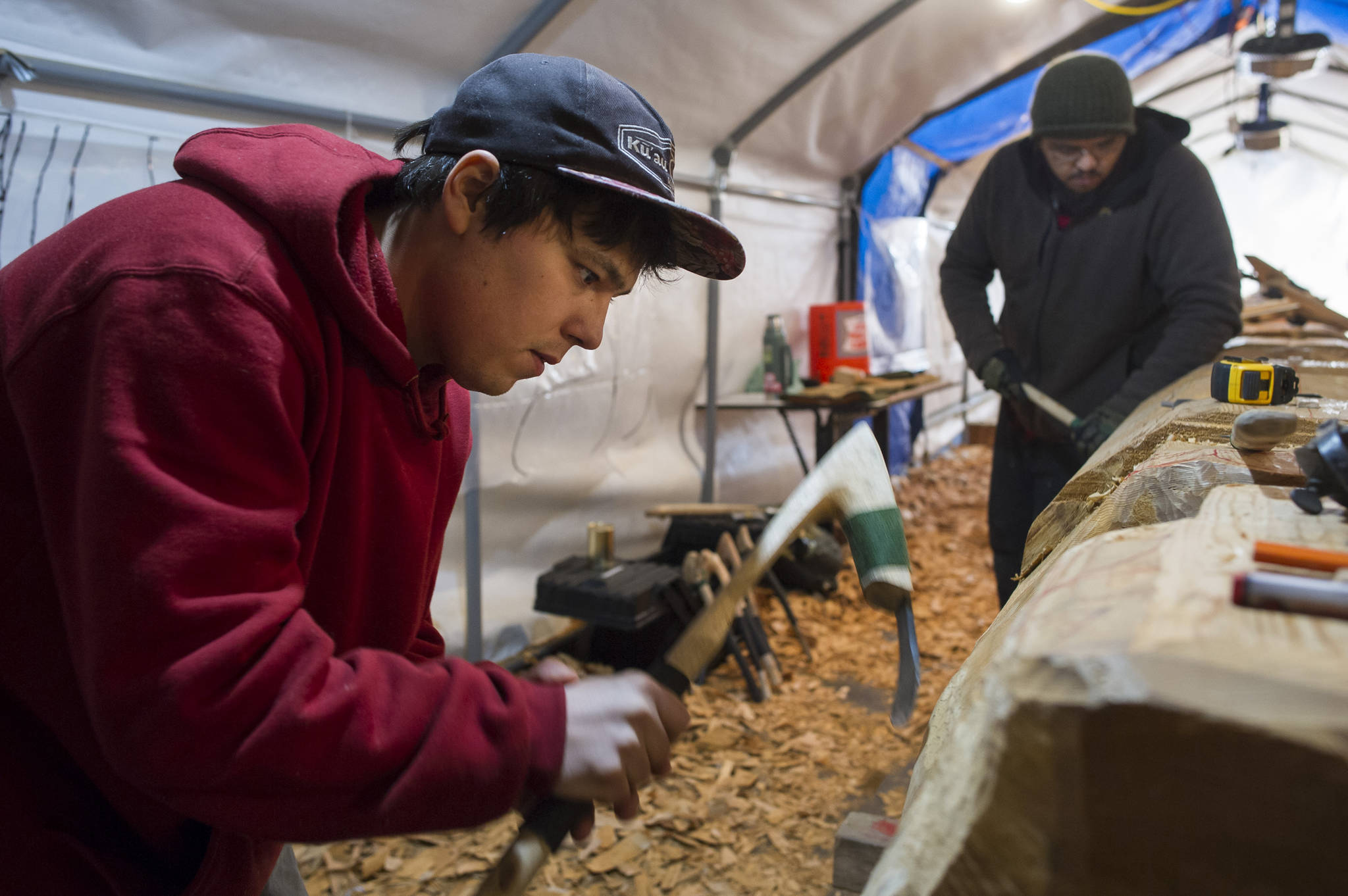Nicholas Galanin can’t wait to see the totem pole from far away.
Galanin, the lead carver on a 40-foot Yanyeidi Wolf totem pole that will go up in Savikko Park on Douglas Island next year, sipped from a cup of coffee as he looked up and down the work in progress this past Tuesday. The design, which depicts two giants, the Taku River, clansmen, a bear holding a shield, the sun, a wolf and more, is starting to take shape.
Almost everybody who sees the pole will experience it only in its finished form, and from the ground. This past Tuesday, Galanin was thinking about what that finished product will look like.
“I’m intrigued to see it from a distance,” Galanin said. “We’re arm’s length from it and we’ll be arm’s length from it for months.”
The pole will join another totem pole, a Raven pole now located at Sayéik Gastineau Elementary School, as part of the “A Time for Healing” project. Goldbelt Heritage Foundation (GHF) applied for grants for the program and has been collaborating with the Douglas Indian Association in designing and creating the poles.
In 1956, the City of Juneau paved over a Tlingit cemetery to build the Douglas Highway and the elementary school. When renovating the school a few years ago, city contractors unearthed a few more of the graves unintentionally. The Raven pole at the school was meant as both a memorial of past injustices and a symbol that it’s time to start healing those old wounds.
The Yanyeidi Wolf pole is going up at Savikko Park to memorialize when the City of Douglas burned down the Douglas Indian Village in 1962 to build Douglas Harbor.
GHF Language and Projects Lead Fred White said though the original plan was to make this an Eagle pole, a committee of elders from GHF and DIA decided instead to honor a specific clan of the Eagle moiety, the Yanyeidi. White said that originally, the two Tlingit moieties were Raven and Wolf, so the wolf pole also honors that original moiety identity.
Galanin, a Tlingit artist who lives in Sitka, said it’s important to honor the past, but natural lands are still being taken away by government entities.
“It’s not just one portion of history,” Galanin said. “This is something that’s ongoing. It’s been happening. It’s still happening.”
Galanin, 38, referred to the recent presidential decision to reduce the size of two major national monuments in Utah, Bears Ears National Monument and Grand Staircase-Escalante National Monument. As speakers said at the totem raising ceremony in May, these totem poles on Douglas are as much about the present and future as they are about the past.
The carving process began earlier this year, with Galanin as the lead carver, Herb Sheakley as the lead apprentice carver, Raymond Walker and Lee Burkart as carvers and GHF Youth Leadership Mentor &Language Apprentice Shane Brown, and White also involved.
Like the Raven pole before it, the Yanyeidi Wolf pole is kept behind Harborview Elementary School. The carvers meet there to work on it most days, with Galanin flying back and forth between his home in Sitka and Juneau to work on the pole. He’s worked on many carving projects in the past, but this is his first time as a lead carver for a totem pole.
Elders at the DIA did most of the design, White said, which is meant to be representative of the Yanyeidi Tlingit people. A Yanyeidi clansman sits atop the pole, holding a spear as both a defender of his lands and a hunter. Below that are the giant brothers of legend who are represented by the two high mountain peaks that are visible as one enters the Taku River basin.
Between the two figures of these brothers is a section signifying the Taku River itself. It will have salmon carved into it and a heart in the middle, representing an island in the river between the two mountains. The next figure below the brothers is a bear holding a copper shield, which represents truth, strength, endurance, longevity and spiritual vision.
Below the bear is the sun, representing the village in Douglas that was burned down. The village was located in the part of Douglas where the sun shone first as it rose. At the bottom of the pole is a wolf, holding up the pole. White said they’ve been working with City and Borough of Juneau’s Parks &Recreation Department to design a whole park for the pole.
White said the location is important historically, but will make it difficult to maintain the pole. Being right on the water, sand will be blowing on it and saltwater spray will corrode the paint and the wood, White said. They’ve been working on finding heavy-duty paint and finish to weather the sprays and sand, but he said it will need renovating fairly soon after its installation.
“It will probably last for 10 years, 15 years,” White said. “We’ll do our best to preserve the art on it, put finishes on it.”
Beyond the protection for the pole, Galanin wants to make sure the artistry is accurate. He comes from a family of Tlingit artists and wants to make sure this pole fits into the canon of Tlingit artwork that has spanned generations.
“The biggest challenge is to try to maintain a certain level of artistry that’s been held by artists that have done this work for generations before,” Galanin said, “so we’re just trying to enter that continuum and try to honor it as well.”
• Contact reporter Alex McCarthy at 523-2271 or alex.mccarthy@juneauempire.com. Follow him on Twitter at @akmccarthy.

